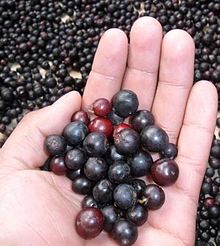Vaccinium meridionale, agraz or Andean blueberry, is a species in the section Pyxothamnus of the genus Vaccinium, in the heath and heather family. It is found in the mountains of Ecuador, Colombia and Venezuela and may have been introduced to Jamaica. Like so‑called wild blueberries in North America, it is artisanally tended in a manner that differs little from wild growing conditions, with few inputs. Its fruit is gathered in the wild and widely sold in local health food markets and grocery stores.[3]
| Vaccinium meridionale | |
|---|---|

| |
| Scientific classification | |
| Kingdom: | Plantae |
| Clade: | Tracheophytes |
| Clade: | Angiosperms |
| Clade: | Eudicots |
| Clade: | Asterids |
| Order: | Ericales |
| Family: | Ericaceae |
| Genus: | Vaccinium |
| Species: | V. meridionale
|
| Binomial name | |
| Vaccinium meridionale | |
| Synonyms[2] | |
| |
Description
editIt is a shrub which measures from 1.5 m to 7 m in height. The leaves are simple, alternate, elliptical to oval in shape, coriaceous (leathery), with a sharp, slight apiculate apex, cuneate base and a crenate margin. The flowers are tetramerous, or sometimes pentamerous, with a white corolla, possibly marked with pink or red. The inflorescence is racemic, producing 10 to 15 flowers per raceme. The fruits are round, approximately 1.2 cm in diameter, green during growth and dark red (giving the appearance of black or violet) upon reaching maturity, with an acid taste.[4][5]
Planting and genetics
editIt is planted in plots at distances of 3x2 meters, without modifying its habitat since it is a wild species. The best propagation is obtained with seedlings with root buds from old lianas. As natural habitats disappear, there is a growing trend of cultivating wild vegetal species in seed banks.
When propagation is done using seeds, the seedlings can be transplanted after a year and a half; when stakes are used, the transplanting can be done at six months by the rooting of branches, or layering. The productive life of the plants can extend to up to eight decades, with two fruit harvests per year.
The successful conservation of the Agraz requires familiarity with its reproductive biology. This is a clonal plant that produces genetically identical individuals through vegetative reproduction, whose genetic structure is complex, with a mix of plants that arise from sexual and asexual reproduction; it is therefore advisable, in addition to field collection, to keep the seeds of a few plants, for a greater representation of genetic variability. Cytology is 2n = 48.[6]
Cultivation in Colombia
editIn Colombia, the presence of this plant has been recorded between altitudes of 2,200 and 3,400 meters above sea level, and it is the only tropical country that proffers two annual harvests of this fruit. A group of researchers from the UN in Medellin chose as field work crops present in the municipalities of Guachetá in Cundinamarca; California in Santander; and La Ceja, Santa Rosa de Osos and Entrerríos in northern Antioquia. This study determined that these red berries, which are often consumed in processed form, undergo changes during their stages of maturation that affect their antioxidant levels.[citation needed]
References
edit- ^ Prodr. 62. 1788
- ^ "Vaccinium meridionale Sw". The Plant List.
- ^ Medina Cano, Clara I.; Martínez Bustamante, Enrique; López Orozco, Carlos A. (2019). "Phenological scale for the mortiño or agraz (Vaccinium meridionale Swartz) in the high Colombian Andean area". Revista Facultad Nacional de Agronomía Medellín. 72 (3): 8897–8908. doi:10.15446/rfnam.v72n3.74460.
- ^ Ruiz Pérez, Gimena (2011) «Mortiño, fruta promisoria para la salud y la economía del país.» Archived 2016-03-05 at the Wayback Machine un Periódico 145.
- ^ Castañeda Riascos, Ivonne Marcela (2006) «Caracterización y divulgación del conocimiento de poblaciones de (Vaccinium meridionales) mortiño, presentes en los bosques alto andinos de la jurisdicción de Corantioquia. Segunda fase.» Archived 2016-03-04 at the Wayback Machine Tesis de grado. Universidad Nacional de Colombia, Medellín.
- ^ Redpath, Lauren E.; Aryal, Rishi; Lynch, Nathan; Spencer, Jessica A.; Hulse-Kemp, Amanda M.; Ballington, James R.; Green, Jaimie; Bassil, Nahla; Hummer, Kim; Ranney, Thomas; Ashrafi, Hamid (2022). "Nuclear DNA contents and ploidy levels of North American Vaccinium species and interspecific hybrids". Scientia Horticulturae. 297. Elsevier BV: 110955. doi:10.1016/j.scienta.2022.110955. ISSN 0304-4238.
